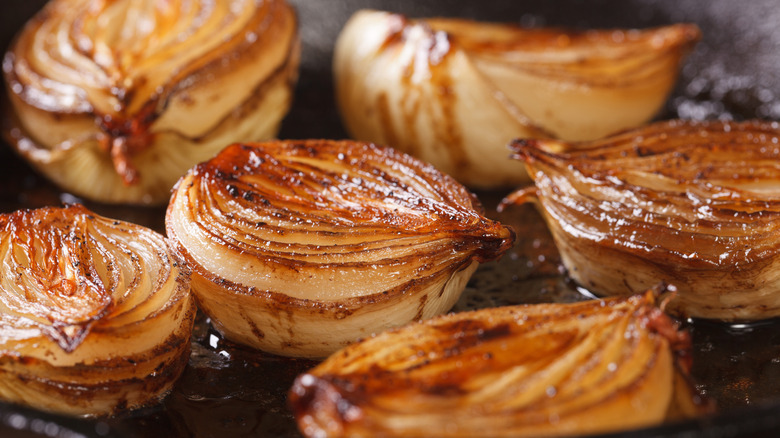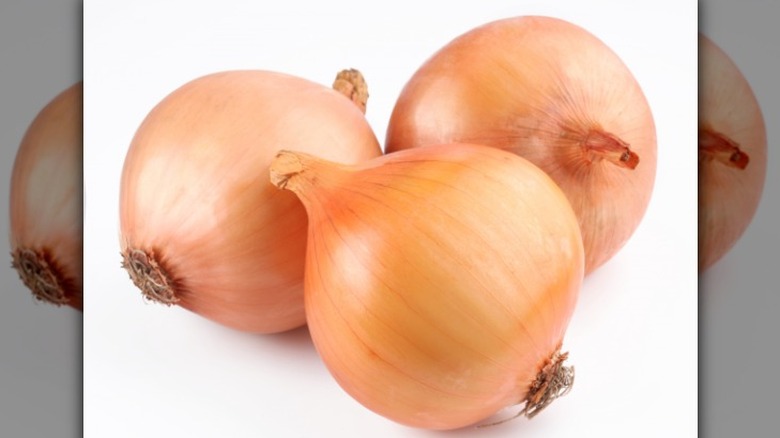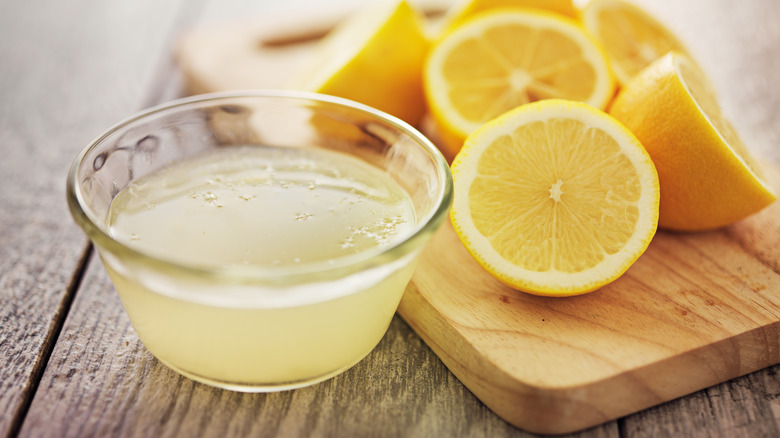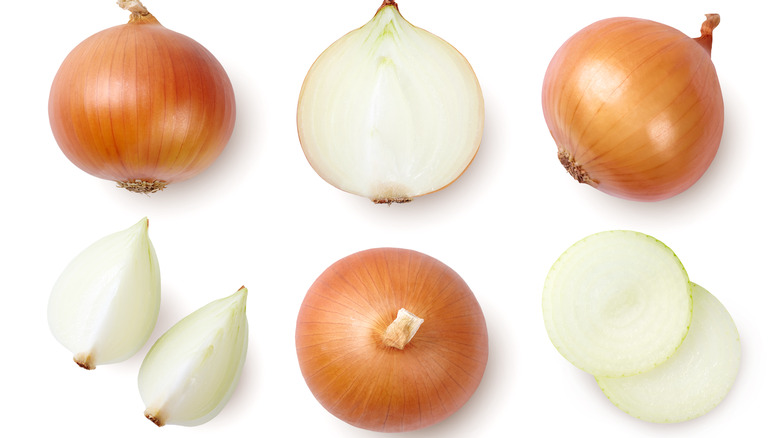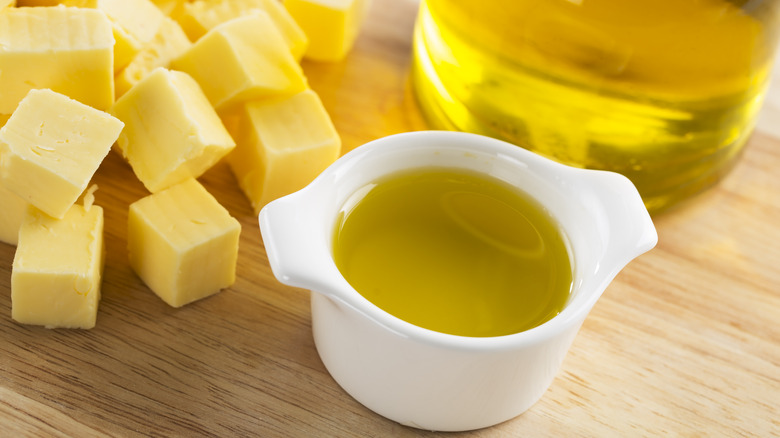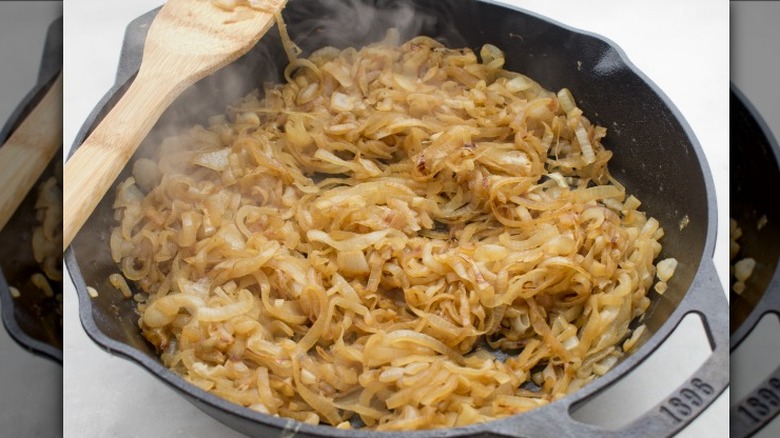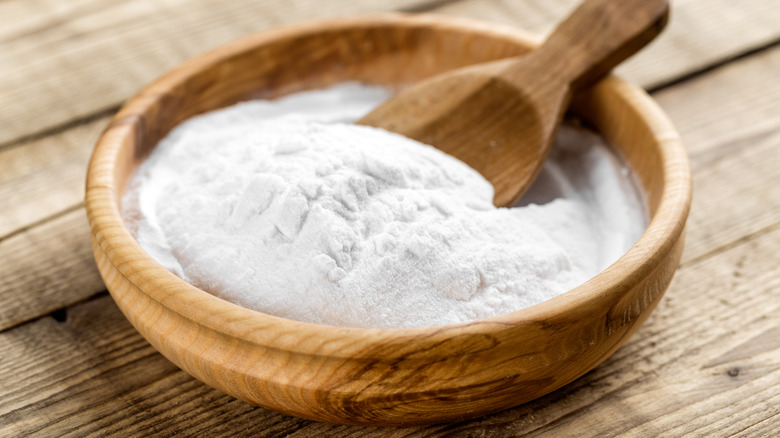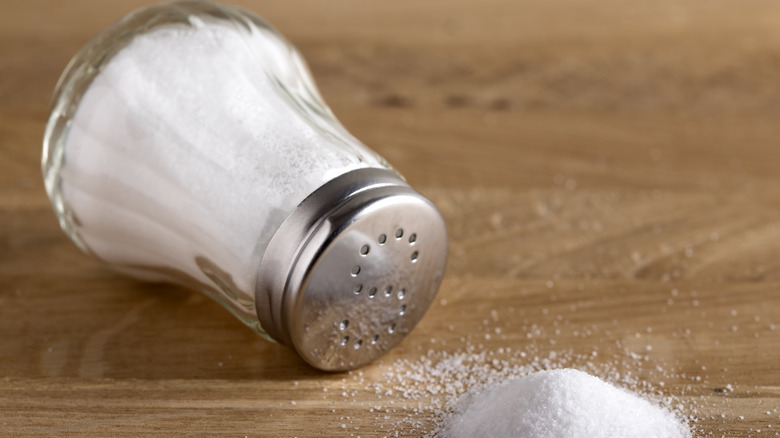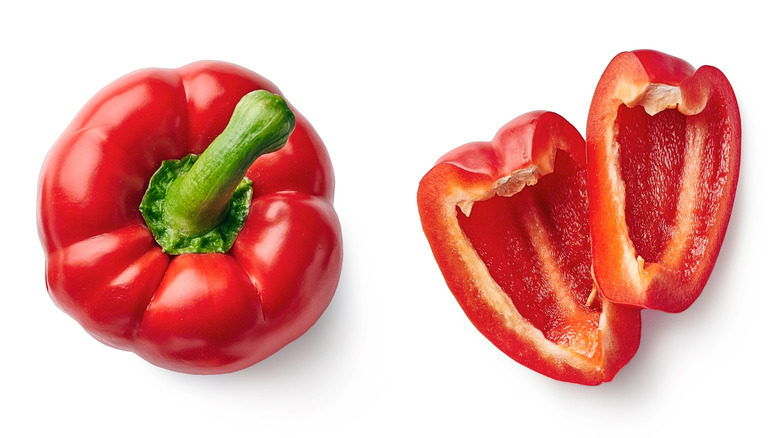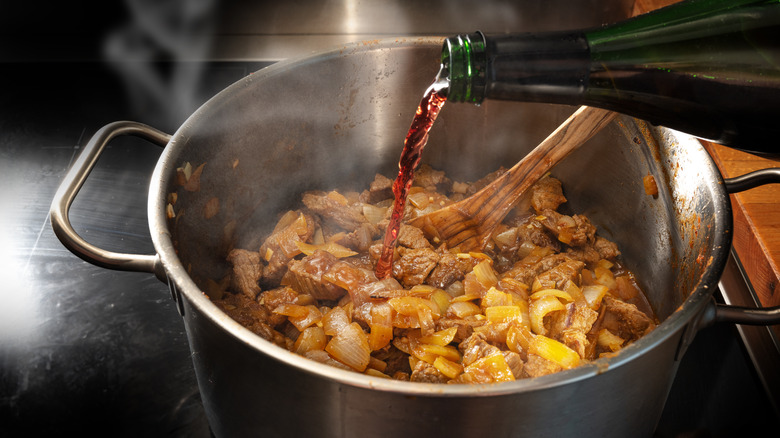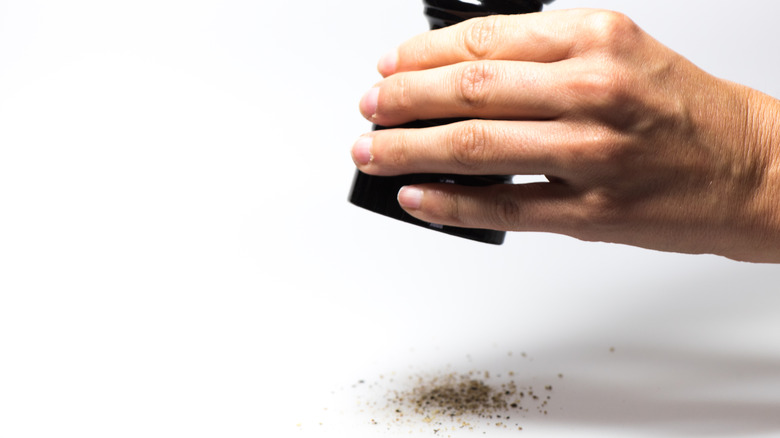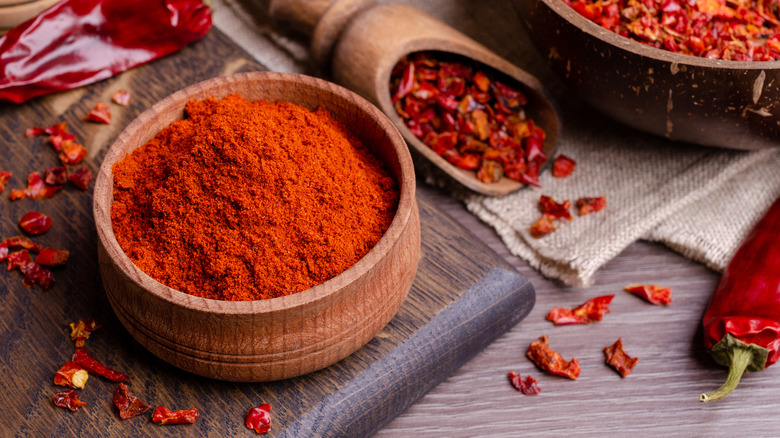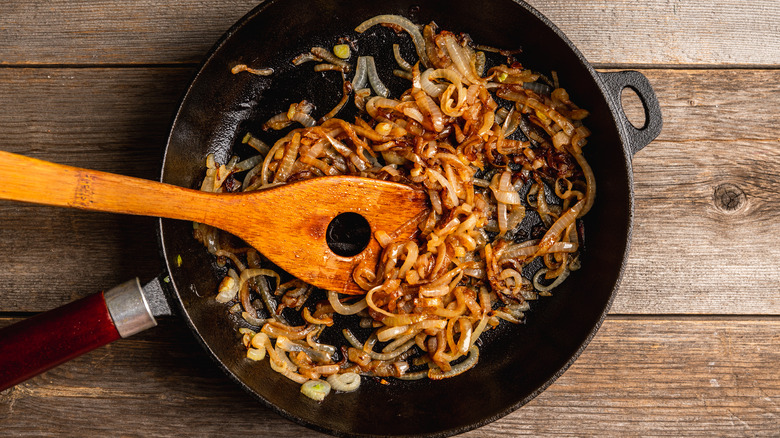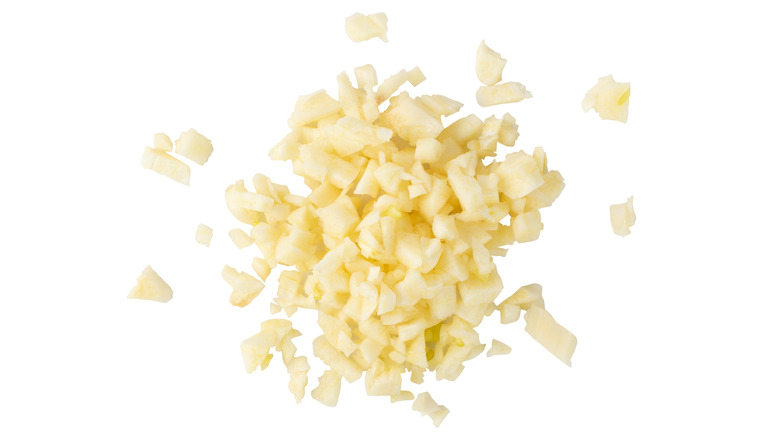14 Ways To Take Caramelized Onions Up A Notch
Who doesn't love the aroma of caramelized onions?! Alone, they can make for a mouth-watering bite. More so, the umami-rich transformation of your onion can be game changer when it comes to your meals and appetizers. It's all thanks to the process of slow-cooking them. Heating them in a skillet at 300 degrees Fahrenheit for up to 45 minutes will do. And, if you cook it just right, the onion's natural sugars will release, it will soften, and the sweet-earthy mélange of flavors will unfold.
But, if you want to take it up a notch to make them even more mouth-watering amazing, there are some great ways to do so without adding much (if any) sugar or more oil than necessary. In fact, it may be as simple as the onions you choose and the way you cut them. We have several other great ways to jazz them up, too!
1. Use Yellow or Spanish Onions
Slow-cooking any type of onion over low heat for some time will reap you the benefit of caramelization. It typically takes a good 45 minutes for a full jam-like consistency and it will surely be worth your time and patience. But not every onion is best suited for this method of cooking. Maui onions are already quite sweet, and onions will get sweeter as they caramelize. As a result, any sweet onion will result in overly-sweet caramelized onions which may over-power your savory dish. Red onions, on the other hand, have a more pungent, sharp edge, which may not mellow out quite enough for a proper caramelization.
The type of onions best suited for the task are your more middle-ground (not too sweet, yet not too sulfury) yellow and Spanish onions. These varieties will give you the most in terms of flavor balance and overall appeal once caramelized.
2. Soak your Onion in Lemon Juice
While yellow and Spanish onions have the least pungency, they still contain sulfurous compounds that can deliver a biting edge. But there is a good hack for reducing its bitterness. You can mellow out your cut onion by soaking it (prior to cooking). Some prepare a water bath, while others prefer vinegar. But there is another option you may enjoy even more.
To take your caramelized onions up a notch, you can start by soaking your raw, chopped onion in lemon juice. Once an onion has been cut, it releases its sulfurous compounds. But the acid in the lemon will help mellow the onion out. What's more, you will get a lemony essence.
How long should you soak your raw onion slices? According to Cooks Illustrated, you can soak them anywhere from five to 15 minutes, but the latter tends to be most effective in mellowing out the onion's pungency.
3. Cut your Onion into Even Slices
Set yourself up for success by slicing your onions with care. It's important to know that how you cut your onions will make a big difference in the end product. It can affect how long you'll need to cook them, how evenly they will cook, and how much pungency is released. First, halve your onion lengthwise root to stem, so that you will see the rings of membrane in each half. If you simply cut in half, across the center, it will impart more serrations to the onion's myriad of layers. Hence, cutting pole to pole, means you'll create less "damage" to the structure of the onion — and this will prevent high amounts of sulfuric release — a highly pungent odor. As a result, this keeps your onions on the mellower and more sweeter side. Then continue slicing lengthwise until you get 1/8 or 1/4 inch slices. Note: If you cut your slices too thin, they can become mushy in the pan; too thick, and they may burn before reaching their fullest flavor potential. Lastly, be sure to cut as evenly as you can. Various sized slices will cook unevenly and you won't get the ideal melt-in-your mouth consistency when your cooking is done.
4. Use Both Butter and Oil
A good rule of thumb for caramelizing your onions is a tablespoon of oil (or butter) per large onion. This amount of fat ensures you won't add too much and end up frying them to a crisp; nor will you end up with a dry, crusty pan. (Though we do love deglazing to pick up any crispy bits that may come toward the end of your caramelization.) While oil alone can work, swapping out some for a bit of butter will elevate your onions to a richer, smoother "buttery" flavor and an enhanced mouth-appeal.
So, why not just use butter? Well, for one thing, it is high in saturated fats. Olive oil is considered a more heart-healthy option as it has a higher concentration of monounsaturated fats. (These monounsaturated fats make up about 75 percent of the oil's content.) Furthermore, olive oil has a higher smoke point than butter.
Your cooking can benefit with a bit of both. Since you'll be cooking the onion for quite some time, the oil-butter combination won't burn as quickly as using butter alone. And, you'll get the butteriness you desire without any of the negative health impacts.
5. Cook Low and Slow
Because caramelization requires time and patience for the onions to release their natural sugars, you'll want to cook your onions "low and slow," meaning over low heat for a period of time. Heating your pan properly is one measure to prevent the onions from sticking to the pan. That's because preheating helps wick the food's moisture away from the pan's surface and provides an ideal temperature to help your fat (butter, oil, or combination of both) spread more evenly on its surface, so your food will slide rather than stick. You'll then add your oil or oil-butter combination to lubricate it, followed by your uniformly cut onions. And depending on the level of caramelization you desire, you may cook your onions over low heat anywhere from 15 to 45 minutes.
Keep an eye on your cooking. If you prefer a more al dente (rather than melt-in-your mouth) texture such as what you'll get in a French onion soup, you'll cook them for less time. Check every 15 to 20 minutes to get your ideal finish. They'll be golden before they brown. The longer you cook them the darker brown they will become. A medium level (a golden brown) may be more ideal for making a proper quiche. But cooking to the fullest extent (45 minutes or more) will make them deeply browned, and softened with crispy edges — a perfect pairing for a mouth-watering steak.
6. Use a Bit of Baking Soda
Baking soda has a multitude of uses — from leavening your baked goods to cleaning and deodorizing. It may even help soothe the burn of acid reflux, as it is an alkaline with a pH of 8 — just a wee bit higher than the neutral pH of 7. For some, a teaspoon of baking soda dissolved in eight ounces of water can be just the trick to cooling that heartburn. But did you know that baking soda can perform wonders in your skillet, especially when it comes to caramelizing your onions? Not only will you discover that baking soda can help soften your onions, it will help speed its browning and the release of the onions aromatic compounds — all of which are key to a successful caramelization.
The high pH in baking soda weakens the onions structure (which releases more flavor, including its sweetness), according to Cooks Illustrated. Add no more than 1/8 of a teaspoon per three large onions. But watch your cook time, because the faster breakdown may result in mush if you cook your onions for a full 45 minutes. In fact, you may have your dish ready in just 15 minutes.
7. Use Salt, or Sugar and Salt
Chefs often use salt when caramelizing onions and there is a good reason for this. Salt has multiple benefits in cooking. For one, salting before cooking draws out moisture from your foods. This will help speed up the process of cooking the onion. Salt also enhances the natural sweetness of foods — a perception that your tongue will love. Additionally, it can help balance out the overall flavor in your food.
A little sugar may be added, too — to save some cook time, while obtaining a desirable level of richness. The sweetener will help speed up the caramelization process without any increase in temperature. Though you won't want to turn up the heat because it can end up cooking your onion before it has a chance to properly soften. Still, don't go overboard because we aren't cooking up dessert. You may only need just a pinch.
8. Add Bell Peppers
Caramelized onions complement many types of dishes from burgers and quiches to cheese platters. They are also a hallmark of French onion soup. But, to kick it up a notch nutritiously and deliciously, use bell peppers, too! Bell pepper will add to its depth of flavors, and will also colorize your dish.
And while any bell pepper may do, choosing your bell pepper can be just as important as using the ideal onion. Green peppers are the least sweet and impart some bitterness. But red is the sweetest variety because it has been on the vine the longest. As a bonus, the red bell pepper is the most nutritious of them all. Though any bell pepper will give you a good dose of essential vitamins and antioxidants to keep you on the road to good health.
Slice your bell peppers consistently like you did for the onion for the benefit of cooking evenly. You may pre-salt them prior to cooking, too — to release their high moisture content to allow for more flavors to soak in as they cook. (Bell peppers contain as much as 94% water). But you'll want to start cooking your bell peppers first because they take longer to soften than the onion.
9. Deglaze the Pan with Vinegar
When you reach a deep browned caramelization of your onions, you will likely get a bit of crispiness. This crispiness is a lovely complement to the mostly jammy consistency of your slow-cooked onions. Deglazing your pan with vinegar will ensure you get all those crisp bits of flavor that may otherwise start to stick to the pan. It will also give your onions a nice flavor punch because vinegar adds pucker-y goodness –– a boost of added flavor. And what's great about vinegar is that it is a low calorie, low sodium option with very little sugar (if any), though aged Balsamic vinegars are sweeter and do contain some sugar. Sherry and balsamic vinegar are some great options. But you might want to experiment with the tangy sweet rice vinegar or a champagne variety.
To deglaze, add a couple tablespoons of the vinegar once your onions started to soften and brown. When the liquid starts to boil, start scrapping any crispy bits that have stuck to the pan. You can repeat this process throughout your cooking until you get the degree of browning and tenderness you desire.
10. Add Black Pepper to Taste
A sprinkling of black pepper can give your foods a slight kick and a greater depth of flavor. And it may have nutritional value, too. The compounds in black pepper may improve the bioavailability of certain phytonutrients for better absorption. This means there's a better chance your body will more fully utilize essential nutrients (such as the calcium in your onion) so you can stay healthy.
When it comes to your caramelized onions, the sharpness of the black pepper will add a bit of pep to your dish and can add nuance to its caramel-y sweet notes. For best results, add a bit of black pepper once your onions start to soften. If you like that pep it gives you, add a little more just before serving it up. Feel free to use whatever pepper you have on hand, but freshly ground black pepper will almost always give you the best flavor results.
11. Liven it up with Chili Powder
Caramelized onions already provide a complexity of flavor, but if you want to liven it up a bit more, you can certainly turn up the heat with some chili powder. In addition to enhancing the flavor potential, chili powder elicits a salivary response for a more mouth-watering effect. That's because of its capsaicin, which is responsible for its heat inducing qualities. Therefore, you don't want to go overboard because your tongue is quite sensitive; and you will definitely feel the burn. And because everyone is different, it may be best to add just a bit toward the end of the cooking process or just a hint before ready to serve. Once your onions are jammy, browned, and ready to serve, add your chili powder to taste. Or if you find that chili powder is too strong but still want a little heat, a spice combo that like Taco Seasoning, which adds warmth and spiciness, but not excessive heat, might just be the key.
12. Sprinkle on Nutmeg
Nutmeg is a spice that gives carrot cakes, pumpkin pies, and eggnog an uplifting appeal. As such, it is a spice staple for Thanksgiving and the winter holidays. But keeping that nutmeg in your spice cabinet also helps flavor up potatoes, carrots, yellow squash, and meats, as well as soups and stews. With its warm, nutty, and aromatic flavor it can be used to complement plenty of savory dishes. Why not add finish your caramelized onions with a hint of nutmeg?!
Grab a nutmeg seed and get grinding! Or use the ground form of the spice if that's more handy. (Although, it may be good idea to check the expiration date, because ground versions of spices degrade faster and lose their flavor over time.) You'll only need a pinch or two to season those caramelized onions because nutmeg is boldly aromatic and subtly sweet. Hence, you don't want to over-power that well-rounded flavor synergy from the caramelization of your onion.
13. Toss in some Garlic
Fresh garlic provides a potency and flavoring that you can't deny, but you'll want to cook it to tame it bite. Its aromas release when roasted or sautéed, which mellows it out, while eliciting an exquisite flavor appeal. More so, onions and garlic go together like PB & J. As the pungency of garlic mellows while cooking, its warmth of flavor combines with the umami-ness of the onion. Yes, it's high in glutamate, which elicits an umami-inducing flavor. And when caramelizing those onions, the glutamate is "freed" creating a stronger umami flavor.
You can mince your garlic and add it to your softening onions to take those caramelized onions up a notch. But beware, minced garlic cooks much faster than your sliced onion. It can burn easily and release a bitter taste. So, you'll want to be sure your onions have softened first in the pan before you add your minced garlic. Be sure to stay on low heat, cook it slow, and stir frequently to get that well-roundedness of flavor and also prevent any amount of bitterness or charring.
14. Pair it with Goat Cheese
You may have enjoyed caramelized onions in a more sophisticated version of grilled cheese or as a generous topping in a juicy patty melt. That means caramelized onions goes well with American, cheddar, and Swiss cheese. And certainly, you've used caramelized onions as a jammy condiment for your cheese platter. So, yes, caramelized onions and any type of cheese can be a match made in heaven.
But one cheese that is particularly delicious with your caramelized onions is goat cheese. The mild, tart, earthy goat cheese complements the savory-sweetness of the caramelized onions. As the goat cheese ripens it becomes sharper and tarter, giving it a more emboldened flavor. Some varieties of goat cheese include Humboldt Fog (which is fresh, young, and mild), Gouda (a semi-hard or aged cheese with a more citrus-y appeal), and the soft goat's milk Brie, which is also on the milder side. Try this caramelized onion dip recipe made with goat cheese the next time you need a crowd-pleasing appetizer, or if you simply just want to whet your appetite.
